Lost gravestones of freedom-seekers unearthed in St. Catharines cemetery

It's early morning in the Victoria Lawn Cemetery in St. Catharines, Ont., – a sprawling graveyard established in 1856 that holds the remains of nearly 80,000 people – and Adam Montgomery and Alan Ernest think they've located a lost gravestone.
Ernest, a cemetery-restoration expert, probes the ground by gently pushing fibreglass skewers through the grass until he hits something hard.
"It's a bit like an archaeological excavation," he said, marking the outline of what he believes is the buried gravestone.
Montgomery and Ernest are part of the Salem Chapel Underground Railroad Cemetery project, which searches for the forgotten graves of former slaves who fled the United States in the 19th century.
Together they pull up the sod and carefully begin to dig around the edges of the marker. Ernest explains that the headstone was likely neglected, and when it fell over the ground slowly swallowed it up.
"The fact that the stone is down three or four inches below grade tells me that in a soil like this, that's 75 years, maybe a little bit longer," he said.
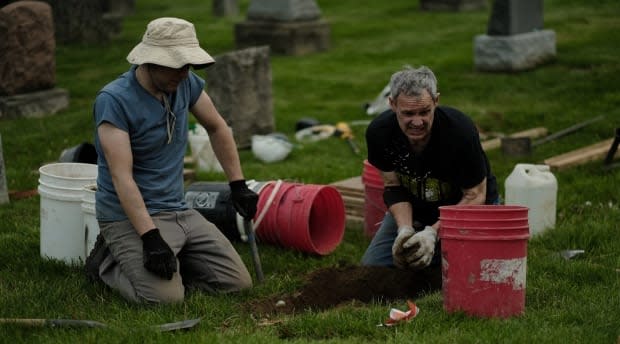
Once Ernest and Montgomery can feel the granite headstone, they abandon their tools and use their gloved hands to gently sweep away the dirt.
"The word 'Mary' is on it pretty clearly here," Montgomery said with excitement. Montgomery is a local St. Catharines historian who specializes in cemeteries.
"I was just thinking about how we're literally uncovering history here," he continued. "This is a chance to be a part of something special."
Historian Rochelle Bush watches the team work – it was her idea to start the Cemetery project. For years she combed through local church archives and researched graveyard maps to find out where former slaves were buried in her hometown.
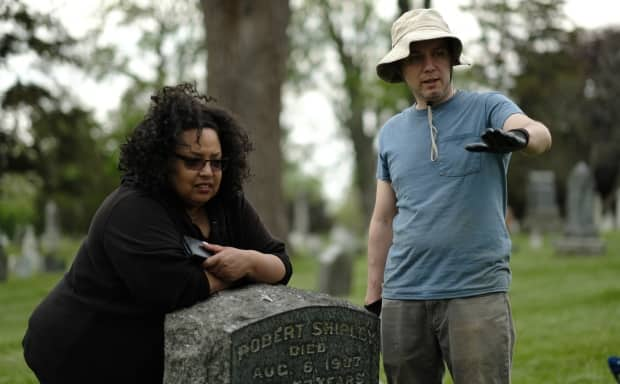
Bush explains that the gravestone belongs to Mary Hutchinson, who was enslaved in Maryland before eventually escaping to Canada with her husband William. Once settled in St. Catharines, they worked with Harriet Tubman – the famous abolitionist who was a key figure in the underground railroad – as part of Tubman's Fugitive Aid Society of St. Catharines.
The story of Mary Hutchinson's heroic life is just one example of what Bush has spent years trying to recover through her project.
"As a kid, I did not learn about Black history in public schools. Not in museums, not in any public spaces," Bush said.
"So outside of our own homes, we couldn't go out and learn anything about us. We weren't celebrated. We weren't recognized," Bush said. "And it matters, because Black people are an important part of the development of this great country the same way as white people. But we're not recognized for that."
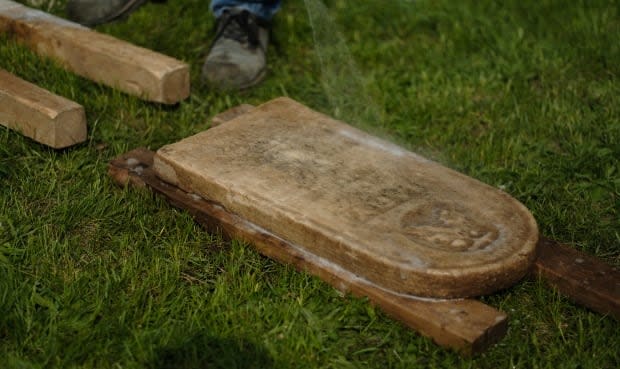
Bush believes there are about 50 former slaves buried in the Victoria Lawn Cemetery whose gravestones have been lost. The team, solely funded by a Go Fund Me page, plans to uncover as many as they can.
They carefully clean Mary Hutchinson's marker and set it aside to dry. They will reset the gravestone in its base so it stands again as it did when Hutchinson died back in April of 1890.
Ernest says working on the gravestones of freedom-seekers is an honour and a responsibility he takes very seriously,
"There's a dark stain on the history of the world. We've still got a ways to go. You know, there's still people being enslaved all over the world."
Direct descendant of a freedom-seeker
After a short break, the team moves on to a new area of the cemetery to work on a gravestone that has a personal connection for one of them.
It's not something you see every day in a cemetery, but Ernest unloads a winch and a long length of chain from his truck and lugs them past several gravestones.
He and Montgomery set up the pulley system and get to work. Their goal is to pull up the deeply sunken base of the gravestone of Amelia Cisco Shadd Williamson (1831-1906). Amelia was an abolitionist and wrote for the Provincial Freeman newspaper, which her sister Mary Ann published and edited. She was the first Black woman in North America to have such a role.
"I think it's kind of interesting the way it sank – it almost went straight down," Montgomery said once they'd dug down deep enough that they could loop belts under the gravestone.
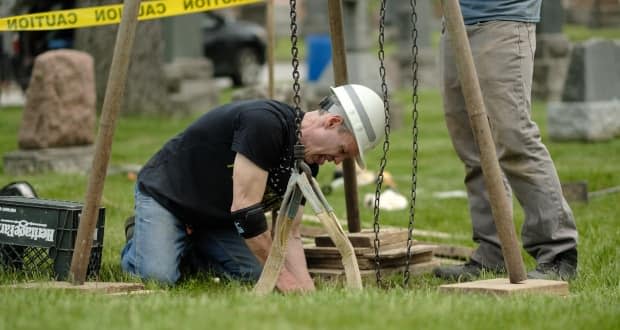
Montgomery explains that he has waited a long time for this moment – to extract and repair the gravestone of one of his relatives.
"One of the things that might surprise people with my involvement in this project is the way I look – I'm white," Montgomery said. "On my mom's side we have Armenian ancestors. On the other side we have African-American ancestors. So I think our family might be a good example of how people might not always look like you expect them to."
Montgomery and Ernest start to use the hand-powered winch, and slowly the heavy granite base rises out of the ground. They settle it onto the grass.
"This is my great, great grandmother," said Montgomery, pointing to the gravestone and suddenly tearing up.
"This is part of our history we've always been proud of," he said. "It's just very special when it's your own kin."
Montgomery's mom, Linda Montgomery, has come to the cemetery to witness her son's work.
"It's our hearts, I guess maybe that's the way to put it," she said. "And I know my dad would be absolutely over the moon to see that Adam was doing this for his family and him as well."
Once the stone is cleaned, the team will repair it and it will stand again as it did when Amelia Schadd died in 1897.

Montgomery explains there's a reason beyond his personal connection for why the cemetery project matters to him. He says that even though the freedom-seekers died generations ago, their stories are relevant today.
"A lot of the same questions that have been dealt with throughout time are still dealt with today. Things like prejudice, things like how do we deal with someone who is different than us, whether it's race, religion, and how do we learn to live together, and all these kinds of big questions," Montgomery said.
"And I think a project like this can help people be inspired to want to think differently about their own life."
That's the dream of Rochelle Bush, as well.
"It's like a eureka moment to actually discover something that we thought was lost forever," she said.
Once all the graves of all the former slaves are found and repaired and put back up, the team hopes to create the first Underground Railway Cemetery walking tour in the country.
That way people can visit the Victoria Lawn cemetery, download an app and learn about the lives of the freedom-seekers who escaped slavery and settled in Canada.
Inspiration
There is one gravestone in particular the team believes will inspire people.
John Lindsay overcame the longest possible odds. He was born a free man in 1805 but was abducted by slave catchers and enslaved in Washington, D.C., when he was only seven years old. He eventually escaped and made it to St. Catharines, where he became a prominent businessman.
"It's the rags to riches story," said Bush. "When he died he was the richest Black man in Niagara. He was very industrious, and he persevered and he did it."
Adam Montgomery chimes in: "We hope he's here. We've done all the research," he said, pointing to a patch of grass in the bright sunshine. "We're hoping that this is it. This is the spot."

The team again begins to dig carefully, systematically removing earth and probing so they don't damage the stone.
"That's why we're not here with a backhoe or even shovels," said Ernest. "We're gonna just use our hands to pull this off – and I've got my one trowel with the metal edge protected."
The work pays off and the team locates a large stone more than a foot underground. But as more of the gravestone becomes visible, there are signs that there's a serious problem.
"Look at this," said Ernest, pointing to cracks and breaks in the stone. "It's an issue."
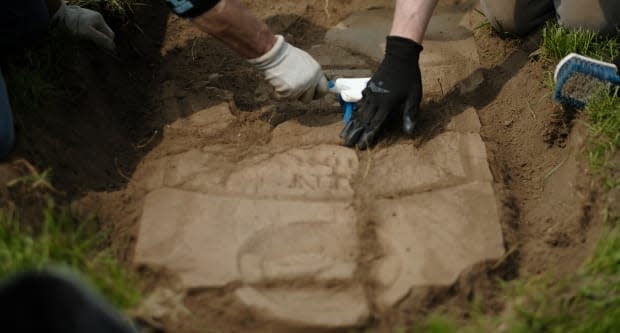
The team continues to work and uncovers the stone completely. Ernest shakes his head.
"We have John Lindsey uncovered now, but unfortunately it's broken into more than 25 pieces. So the disappointing part is we won't be able to get this stone back upright."
Ernest says the stone can't be repaired because the marble has what he calls "advance sugar decay" – just using his fingers, the stone crumbles into a white powder.

For the next hour or so Ernest and Montgomery carefully rebuild the stone on a piece of plywood – putting it back together above ground like a jigsaw puzzle. They hope to be able to display the stone in a specially raised box on the ground so people will still be able to view it.
Bush has mixed emotions.
"It's very disheartening to see that stone is in many pieces," she said. "But I'm grateful that they'll be able to do something with the stone so that it'll be visible and people will be able to look at it, even if it's in many pieces."
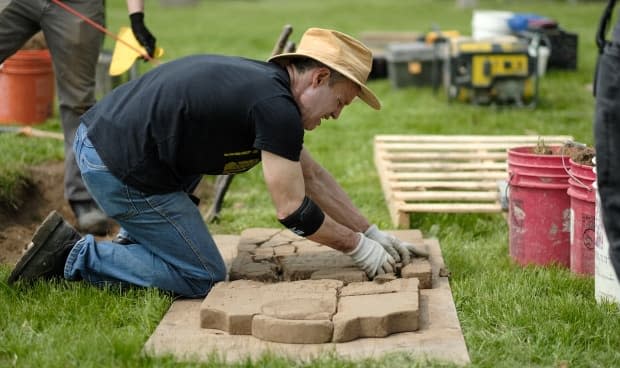
Bush says the state of the John Lindsay stone points to a bigger challenge. The clock is ticking.
She says if the graves of freedom-seekers aren't found and preserved, they could be gone forever. And in a world where increasingly people mistrust almost everything, physical proof – like the headstone of a former slave — is important.
"Of all the discoveries, this is the one that touches my heart the most," said Bush as she high-fives Montgomery.
"John W Lindsay – here at Victoria Lawn Cemetery. Can you believe it Adam? We never forgot about you, brother Lindsay."

For more stories about the experiences of Black Canadians — from anti-Black racism to success stories within the Black community — check out Being Black in Canada, a CBC project Black Canadians can be proud of. You can read more stories here.

